The issue of expanding the living space is often solved by building an additional extension, which, depending on the wishes of the owners of the house, can be a living room, an open veranda, a summer terrace, a boiler room or a bathroom. When arranging such premises, homeowners prefer frame structures that are easy to install and lightweight. In this case, the easiest way is to install such an extension to the house on screw piles. In addition, the homeowner is attracted by the cost savings from using this technology.
- Requirements for screw piles
- Application conditions for screw piles
- Advantages and disadvantages of a pile structure
- Do-it-yourself construction of an extension on a pile-screw foundation
- Preparatory work
- Installation of screw piles
- Features of connecting the foundations of the house and the extension to each other
- Construction of an extension
Requirements for screw piles
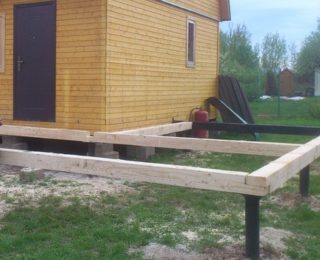
In general, the screw pile is a steel pipe with a wall thickness of 4.5 mm and a diameter of 98 ... 108 mm. Its lower end is sharpened and equipped with cutting blades, the diameter of which should not exceed 300 mm, which makes it possible to “drill” the soil by hand or using a special tool. In the upper part of the pipe there is a hole into which a lever is inserted to screw the pile. This design allows the pile to penetrate deeply into the ground and be well fixed in it. The length of the support depends on the height of the extension and the depth of their burial into the ground. It is better to use purchased piles, but you can make them yourself.
The screw mounts require corrosion protection. For this purpose, a multilayer protective coating (galvanic coating + priming + painting) is applied to industrial piles. When making screw piles with their own hands, a polymer or polyurethane coating is applied to their surface.
Application conditions for screw piles
What kind of screw supports must be used in a particular case is determined as a result of analyzing the data obtained as a result of geological surveys carried out in the area of the proposed construction of the extension. Particular attention is paid to the depth of the groundwater, freezing of the soil, the occurrence of weak heaving soils.
Of no small importance is the thickness of the dense soil layer in the places where the screw piles are installed.
Immersion of screw piles in rocky and / or stony ground is not possible.
Advantages and disadvantages of a pile structure
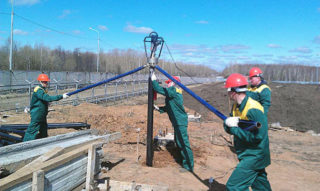
An extension to a house on piles has a number of significant advantages over similar structures based on other types of foundations.
- The construction of the extension can be carried out at any time of the year.
- When arranging pile structures, there is no need for earthworks.
- The construction of pile extensions is carried out in a very short time.
- Pile annexes can be built on almost all types of soil. The only exceptions are rocky and coarse-grained soils, as well as soil densely saturated with stones (crushed stone, pebbles, gravel).
- Exact adherence to the technology of laying the pile foundation ensures long-term and trouble-free operation of the extension.
The disadvantages of the construction of the pile extension include the need to equip an insulated basement and the possibility of damage to metal pile supports by corrosion.
Do-it-yourself construction of an extension on a pile-screw foundation
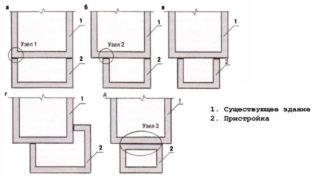
When starting work on laying a pile foundation, it is necessary to check on which foundation the main structure stands, since different types of foundations sag in different ways during operation. If the main building was not erected on a pile foundation, an expansion joint must be provided in the places where an extension adjoins it on a pile-screw foundation.
An expansion joint is the gap between the foundation of the main building and the grillage of the pile foundation. It is closed with strips from the inside and outside of the newly formed structure.
If the house and the extension are installed on pile-foundation foundations, the grillages of both foundations are interconnected into a single whole. When erecting light frame extensions, the role of the grillage may well be played by a wooden profiled beam.
Preparatory work

Before proceeding with the independent erection of the pile-foundation base for the extension, you need to carry out a number of preparatory measures:
- thoroughly clean the work area;
- remove the blind area, equipped along the wall, to which the extension will adjoin;
- mark the construction site by driving in pegs where the corners of the extension will be located;
- pull the construction cord (twine) around the perimeter of the future structure;
- calculate the required number of screw piles, taking into account that the maximum distance between two adjacent supports should not exceed three meters;
- in places where screw piles are supposed to be installed, drill or manually dig shallow pits.
Preliminary preparation of the site will allow you to imagine the real dimensions of the extension and assess the correctness of the calculations.
Installation of screw piles
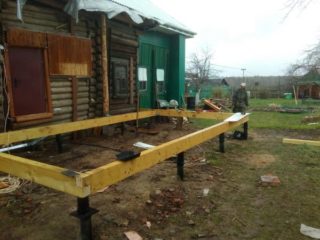
The installation of screw piles starts from the walls of the main structure. In this case, the distance from the wall to the first row of supports should be 0.5 m. Initially, all piles are installed in prepared pits and covered with earth. Only after that do they start screwing them into the ground.
To facilitate the work, it is necessary to prepare a lever with which the piles are screwed into the ground. As a rule, a long metal pipe is sufficient for this. To screw in the support, two, and sometimes four people may be required. In this case, one of them must, using the building level, control the correct installation of the piles.
After all the supports have been screwed in to solid ground, they are cut off at the same level. The height of their protruding parts must be at least 150 mm.
The correctness of the installation of screw piles is determined by:
- with a depth of immersion of the tip below the level of soil freezing - this is especially important when erecting a pile foundation on unreliable soils;
- the coincidence of the cut ends of the piles horizontally;
- evenness of piles vertically.
After making sure that the piles are installed correctly, their inner space is poured with concrete, and the ends are closed with steel heads, with which the grillage is attached to the supports. Depending on the weight of the extension being built, the grillage (strapping) can be made of profiled timber, metal profiles or cast-in-place concrete.
Features of connecting the foundations of the house and the extension to each other
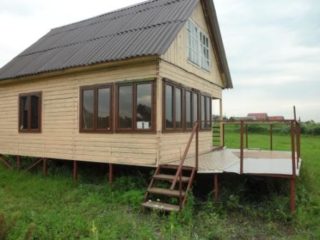
If the house, like the extension, stands on a pile foundation, their grillages are rigidly connected to each other, provided that the buildings are on solid ground. Otherwise, the foundations may be skewed due to their uneven settlement.
If the types of foundations are different, their connection is carried out through an expansion joint.For this, the pile foundation of the extension is placed as close as possible to the foundation of the main structure, and the distance between them is filled with hydro and heat insulating materials. The seam created at the same time will allow the new base to "play" during settlement without damaging the foundation.
The decision to rigidly attach the new foundation to the old one is best made after consultation with experienced specialists. After all, if any distortions occur in the screed, all the work will be ruined.
Construction of an extension
The construction of the extension can be started immediately after the arrangement of the pile foundation foundation. In this case, bricks, logs, SIP panels and other materials are used. However, the best option is considered when the extension to the frame house on screw piles is made of the same materials as the main structure.








